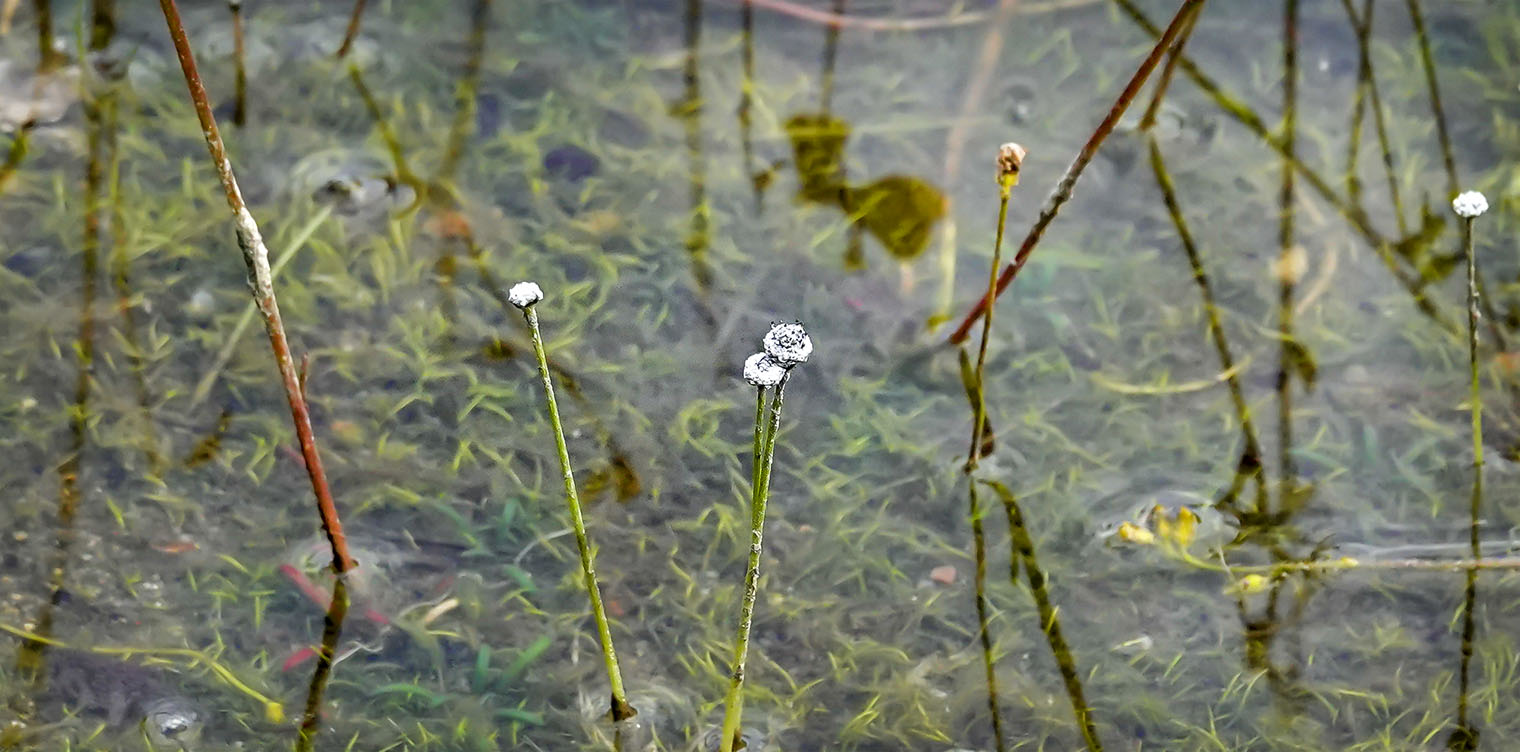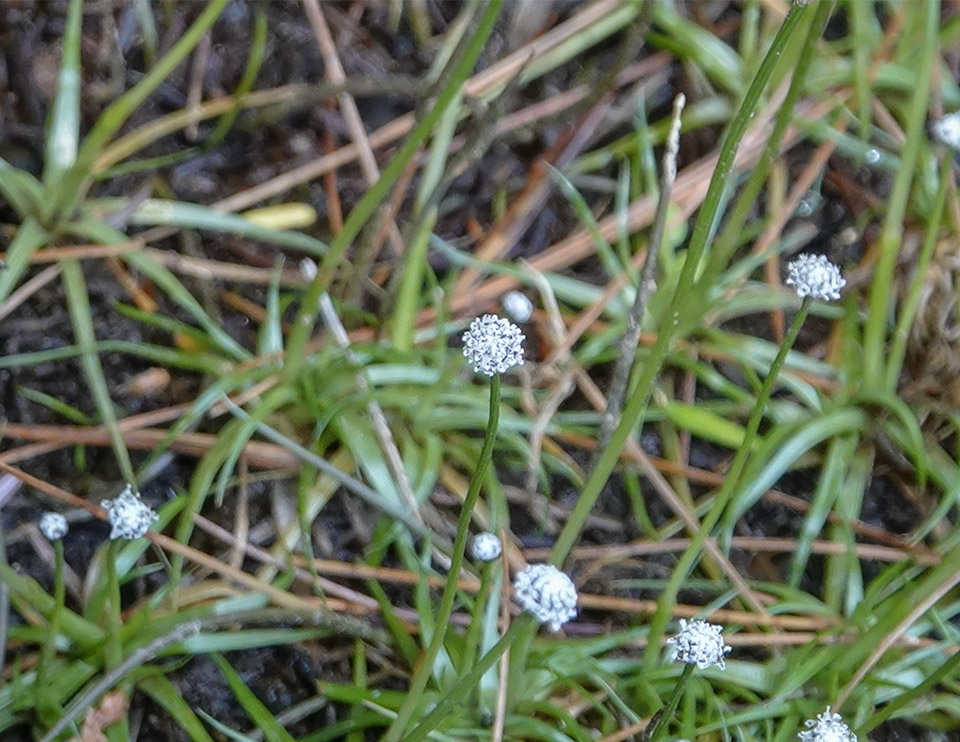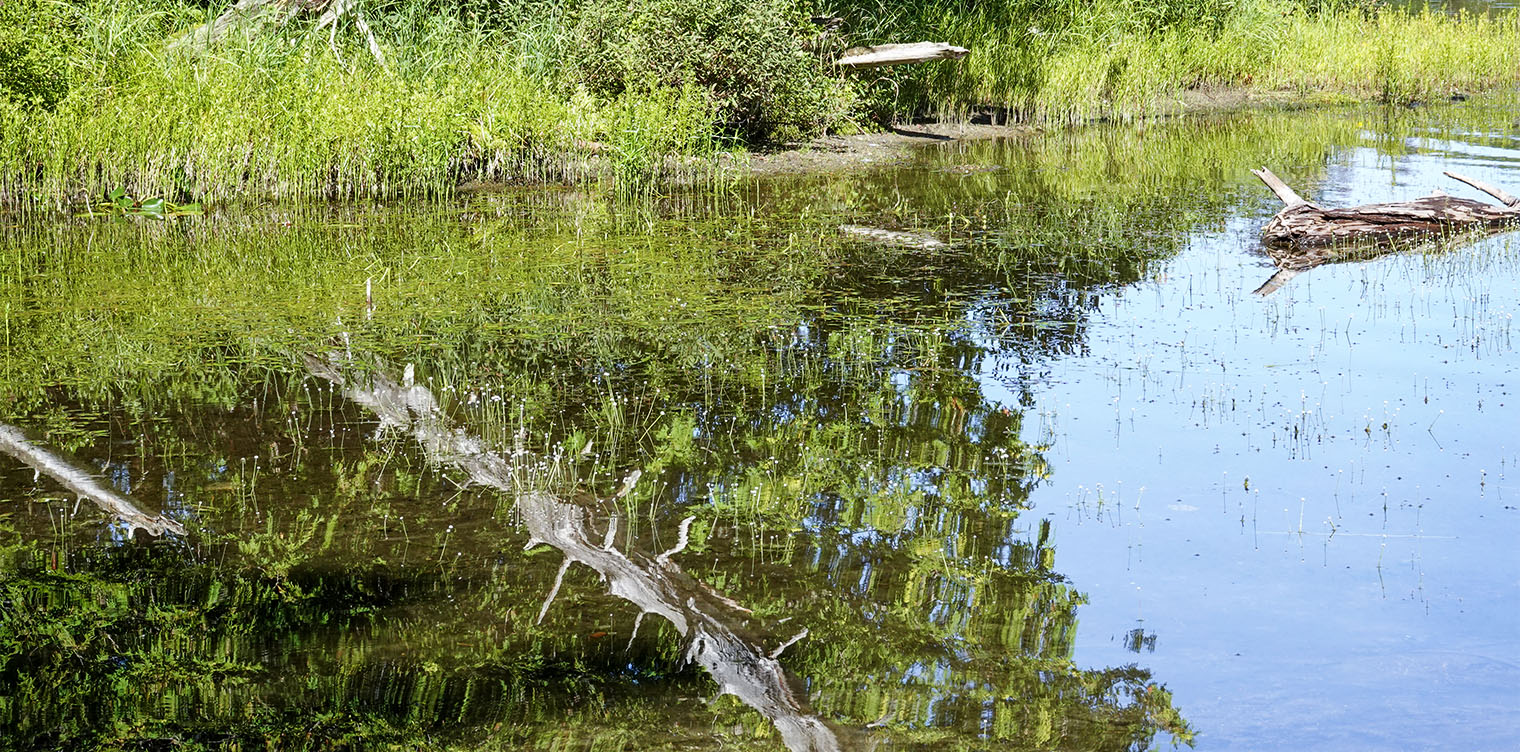Wildflowers of the Adirondacks:
Northern Pipewort (Eriocaulon aquaticum)

Northern Pipewort (Eriocaulon aquaticum) is a wetland plant that produces small white flowers in summer. It grows in Adirondack marshes, bogs, and the shallow water of lakes and ponds.
Northern Pipewort is part of the genus Eriocaulon. There are about 400 species in this genus, widely distributed around the globe. Most species are found in tropical regions. There are about ten species in the US. Northern Pipewort is the only member of the Eriolcaulon genus found in the Adirondack Park.
Other nonscientific names for Northern Pipewort include: Sevenangle Pipewort, Seven-angled Pipewort, Sevenangle Pipewort, and Common Pipewort. This species is also known as Hatpins or Northern Hatpins –a reference to the button-like flowers, which are reminiscent of old-fashioned hatpins.
Identification of Northern Pipewort

Northern Pipewort is an emergent aquatic plantEmergent Aquatic Plant: A plant with roots in the lake bottom, but leaves and stems which extend out of the water. Emergent plants grow in wetlands and in shallow water along shorelines.. It grows two to eight inches tall on land, but may reach a height of several feet when submersed. The height of the plant depends on the depth of the water it is growing in. The flowering stem is a single, upright stalk. The flowering stem is a hollow and seven-sided, with prominent ridges.
The green leaves are grass-like and tapering. They are thin, with three to nine parallel veins running the length of the blade. The leaves are basalBasal: Leaves are confined to the base of the stem. , meaning that they grow from only the base of the plant.
The flower of Northern Pipewort emerges above the water level from the tip of a long, unbranched stalk. The rounded flower head is ⅛ to ¼ inch in diameter. The flower parts are gray, but hidden by dense white hairs. The effect is that of a black and white flower head. Northern Pipewort blooms in the Adirondack region from about mid-July through late August.
The fruit of Northern Pipewort is a capsule. The seeds are light brown or red-brown. A tally for the upland Adirondack areas compiled by Michael Kudish, based on data collected from the early seventies to the early nineties, indicates that the median fruiting date is 30 August.
Uses of Northern Pipewort
No edible or medicinal uses for Northern Pipewort could be found.
Wildlife Value of Northern Pipewort
Northern Pipewort has very limited wildlife value. Pollination is probably by flies. Some species of beetles reportedly feed on the roots and shoots. As with all aquatic plants, the submerged portions of Northern Pipewort helps provide habitats for invertebrates that are used as food by fish and other wildlife species.
Distribution of Northern Pipewort
Northern Pipewort occurs in the southeastern provinces of Canada and the northeastern US states, south to Virginia and Tennessee. This plant is listed as endangered in Indiana, Maryland, and Ohio.
This species is found in many of the eastern and northern counties in New York State. Vouchered plant specimens have been documented for all counties within the Adirondack Park Blue Line except Clinton and Lewis counties.
Habitat of Northern Pipewort

Northern Pipewort is classified as an obligate wetland plant (OBL)Obligate Wetland Plant (OBL): Plants that almost always occur in wetlands. These plants (herbaceous or woody) are found in standing water or seasonally saturated soils (14 or more consecutive days) near the surface. This category includes submerged plants (such as pondweeds), floating plants (such as Common Duckweed), floating-leaved plants (such as White Water Lily and Yellow Pond Lily), and emergent plants (such as Pickerelweed)., meaning that it almost always occurs in wetlands. Throughout its range, it is found in bogs, sandy or mucky shores, and the shallow water along the shores of lakes and slow-moving rivers.
In the Adirondacks, Northern Pipewort occurs in several wetland ecological communities, including:
- Deep Emergent Marsh
- Oligotrophic Dimictic Lake
- Oligotrophic Pond
Look for the small white flowers of Northern Pipewort near the shoreline of Heart Lake. It is found growing in shallow water near two other wetland plants that flourish in the quiet water along the lakeshore: Horned Bladderwort and Water Lobelia. You can also find Northern Pipewort at the Adirondack Interpretive Center, growing in wet, marshy areas near the Newcomb River Bridge on the Sucker Brook Trail.
References
Michael Kudish. Adirondack Upland Flora: An Ecological Perspective (The Chauncy Press, 1992), p. 214.
New York Flora Association. New York Flora Atlas. Northern Pipewort. Eriocaulon aquaticum. Retrieved 18 March 2020.
New York Flora Association. New York Flora Atlas. Eriocaulon. Pipewort. Retrieved 18 March 2020.
Integrated Taxonomic Information System. Eriocaulon aquaticum. Retrieved 18 March 2020.
United States Department of Agriculture. The Plants Database. Sevenangle Pipewort. Eriocaulon aquaticum. Retrieved 18 March 2020.
Flora of North America. Eriocaulon aquaticum. Retrieved 18 March 2020.
Native Plant Trust. Go Botany. Seven-angled Pipewort. Eriocaulon aquaticum. Retrieved 18 March 2020.
New York State. Department of Environmental Conservation. New York Natural Heritage Program. Ecological Communities of New York State. Second Edition (March 2014), pp. 36-37, 41-42, 47-48. Retrieved 17 October 2015.
New York Natural Heritage Program. 2020. Online Conservation Guide for Deep Emergent Marsh. Retrieved 18 March 2020.
New York Natural Heritage Program. 2020. Online Conservation Guide for Oligotrophic Dimictic Lake. Retrieved 18 March 2020.
New York State. Adirondack Park Agency. Preliminary List of Species Native Within the Adirondack Park Listed Alphabetically by Scientific Name and Sorted by Habit. Volume 1. Updated 10.23.2006, p. 60. Retrieved 26 January 2017.
Connecticut Botanical Society. Common Pipewort. Eriocaulon aquaticum. Retrieved 18 March 2020.
Minnesota Wildflowers. Common Pipewort. Eriocaulon aquaticum. Retrieved 18 March 2020.
Illinois Wildflowers. Plant-Feeding Insect Database. Eriocaulon spp. Retrieved 18 March 2020.
iNaturalist. Plant Name. Genus Eriocaulon. Retrieved 18 March 2020.
iNaturalist. Plant Name. Common Pipewort. Eriocaulon aquaticum. Retrieved 18 March 2020.
iNaturalist. Adirondack Park Observations. Eriocaulon. Retrieved 18 March 2020.
iNaturalist. Adirondack Park Observations. Common Pipewort. Eriocaulon aquaticum. Retrieved 18 March 2020.
Donald J. Leopold and Lytton John Musselman. Wildflowers of the Adirondacks (Johns Hopkins University Press, 2020), pp. 6-8, 256-257.
Meiyin Wu & Dennis Kalma. Wetland Plants of the Adirondacks: Herbaceous Plants and Aquatic Plants (Trafford Publishing, 2011), p. 53.
David M. Brandenburg. Field Guide to Wildflowers of North America (Sterling Publishing Company, Inc., 2010), p. 221.
William Carey Grimm. The Illustrated Book of Wildflowers and Shrubs (Stackpole Books, 1993), pp. 36.
National Audubon Society. Field Guide to North American Wildflowers. Eastern Region. (Alfred A. Knopf, 2001), pp. 521-522, Plate 179.
Charles H. Peck. Plants of North Elba. (Bulletin of the New York State Museum, Volume 6, Number 28, June 1899), p. 137. Retrieved 22 February 2017.
